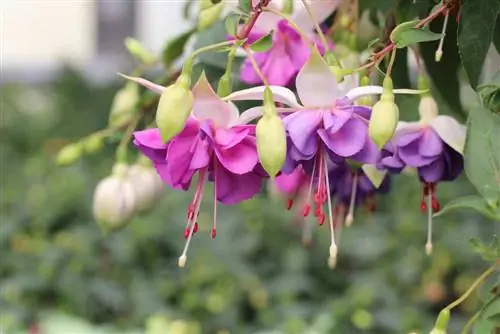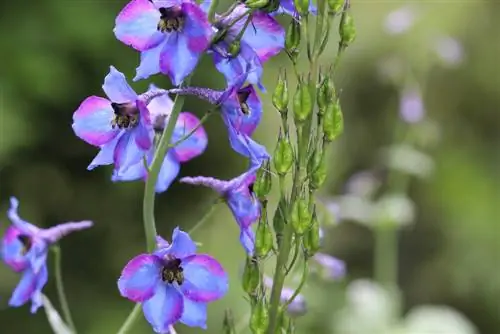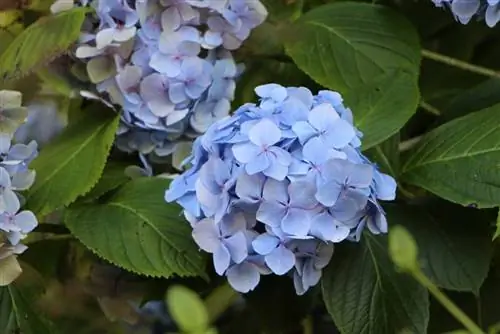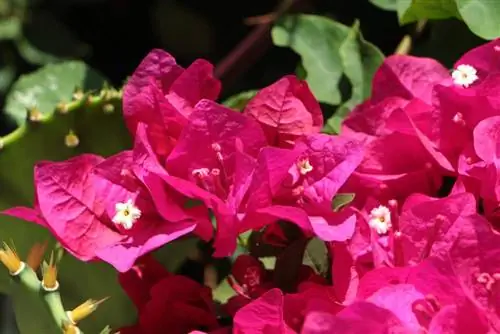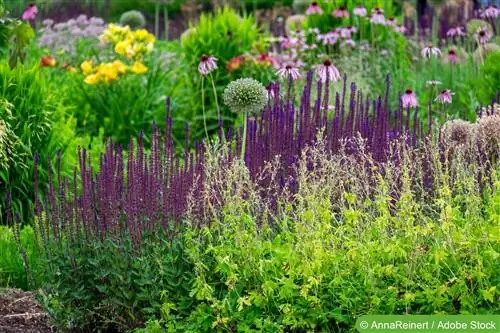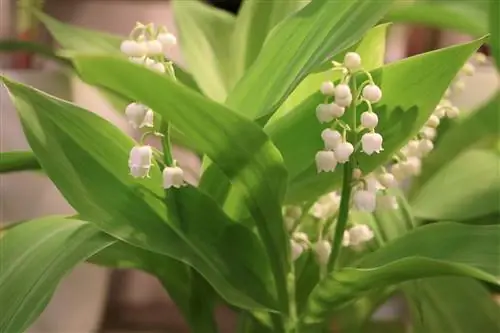- Author admin [email protected].
- Public 2023-12-17 03:39.
- Last modified 2025-06-01 06:48.
In the article cycle about autumn and flowers, you will be introduced to many different ideas for autumn planting and probably all the perennials that (still) bloom in autumn. A few special or new autumn perennials are presented here, and the perennials that bloom from autumn to winter or almost beyond:
Blooming autumn perennials - something new or something special
There are perennials that bloom in autumn, and they do so in a completely different way than our usual autumn bloomers, aster or heather. These perennials are relatively unknown, perhaps simply because they were recently bred or introduced:
- Aconogonon campanulatum, Himalayan bell knotweed, whole bushes in white and pink
- Adenophora stricta ssp. confusa 'Hemelstraling', misunderstood bellflower, new variety with delicate violet-pink bell panicles that is hardy down to -40 °C
- Agastache mexicana 'Sangria', Mexican nettle mint, red-violet, tightly upright growing, unusual panicle flowers
- Agastache rugosa 'Serpentine', a variety of garden nettle that produces blue-purple elongated flowers "feudel" late in the season
- Alstroemeria cultorum 'Andez Red', an Alstroemeria lily, bright red lily flower with small white spots
- Antirrhinum brown-blanquetii, Iberian snapdragon, light yellow panicles with bell flowers
- Bistorta amplexicaulis 'Album', garden knotweed with long white flower candles
- Bistorta amplexicaulis 'Pink Elephant' and 'Rosea': flower candles in light pink
- Bistorta amplexicaulis 'Orange Field': orange-pink flower candles
- B. amplexicaulis 'Inverleith', 'JS Calor', 'JS Delgado Macho': bright red; 'JS Caliente', 'Blackfield', 'Fat Domino': dark red flower candles
- Campsis radicans 'Flamenco', trumpet morning glory, exciting deep orange-red trumpet flowers, trailing roots
- Ceratostigma willmottianum, Chinese leadwort, bright blue flowers, bushy growth
- Eryngium tripartitum, garden thistle, dark blue flowers
- Penstemon cultorum 'Rich Ruby', penstemon variety in which the bells on the panicles are dark pink
- Perovskia atriplicifolia 'Little Spire', blue rue, which shows violet-blue flowers
- Verbena canadensis 'Homestead Purple', Canadian cold-used verbena with pretty purple flowers
Late, later and early flowering autumn perennials
There are also perennials that bloom at Christmas; and even perennials that bloom so late that it's already spring again because of all the blooms:
1. Hardy perennials that bloom until November/December
- Artemisia vulgaris, Mugwort
- Aster ericoides, myrtle aster, varieties 'Erlkönig', 'Golden Spray', 'Autumn Myrtle', 'Lovely', 'Ringdove', 'Snow Flurry', 'Typ Hug', 'White Heather'
- Aster novae-angliae, Raublatt-Aster, varieties 'Alma Pötschke', 'Souvenir of Paul Gerber', 'Barr's Blue', 'Flora Fee', 'Herbstschnee', 'Purple Dome', 'Rubinschatz' ', 'Rudelsburg', 'Schranners Violet', 'Treasure', 'Violetta'
- Aster x frikartii, Frikarts Aster, varieties 'Jungfrau' and 'Wunder'
- Banksia ericifolia, heather-leaved banksia, hardy to -8 °C
- Chrysanthemum indicum, autumn chrysanthemum variety 'Poesie'
- Colchicum autumnale, autumn timeless, also variety 'Album'
- Crocus cancellatus, subsp. cancellatus, trellis autumn crocus
- Cyclamen hederifolium 'Album', autumn cyclamen, varieties 'Album' and 'Pearl Carpet'
- Gentiana scabra, Japanese gentian, undemanding, alpine perennial
- Sedum hybrids 'Indian Chief' and 'Mohrchen'
- Sarcococca hookeriana var. humilis, low Himalayan slimeberry, hardy to -15 °C
2. Hardy perennials that bloom until January/February
- Callistemon phoeniceus, purple callistemon, hardy to -7 °C
- Camellia salicifolia and Camellia sinensis (tea bush), both moderately hardy
- Hardy perennials that bloom until March/April
- Camellia saluensis, moderately hardy
- Camellia sasanqua, in the varieties 'Crimson King', 'Narumi-gata', 'Paradise Barbara', 'Pure Silk', 'Rainbow', 'Wahroongah', only moderately hardy
- Fuchsia arborescens, tree fuchsia
Garden, balcony, terrace
All of the perennials presented do well in most German gardens; if the garden is in harsher regions, they just get some winter protection; and if the garden is in the “final cold hole”, there are still perennials on the list that can endure it. You can also cultivate a lot of these plants on the balcony/terrace, depending on the climate/microclimate, better than in the garden. The deeper the flowering is in the middle of winter or almost in spring, the more likely it is that the flowering of a perennial plant that is used to our climate was not simply extended into autumn through breeding. The correct winter bloomers may also have been bred to bloom at the usual time, but in an unfamiliar (too cold) climate. But that doesn't work in all cold conditions. When purchasing such “almost winter-hardy” plants, you must therefore pay close attention to the information about winter hardiness, the botanical name and the variety name and compare the result with the climatic zone of your place of residence and the microclimate on the balcony.
That means:
- You need to know the hardiness zone where you live. The plant trade works with international hardiness zones developed by the USDA (United States Department of Agriculture) and adopted by most other states. Germany covers winter hardiness zones 5b to 8b: In the coldest areas with USDA winter hardiness zone 5b, average minus temperatures of -26 ° C are measured, the warmest areas with USDA winter hardiness zone 8b only have an average of -9.4 ° C.
- Shop at specialist retailers where you can get plants that are described with botanical names. If these are foreign plants, you should also find information about the winter hardiness of these plants (not frost hardiness, which describes how much frost a plant can tolerate in its homeland).
- Look at the hardiness zone information on the label and realistically assess the chances that this plant has on your balcony. If it says “USDA 9” (minus 1.2 to minus 6.6 degrees) and you live in the country near Rosenheim (climate zone 6a, minus 20.6 to minus 23.3 degrees), you should consider this plant not necessarily buy. It's all just a rule of thumb, in the city it's about half a climate zone warmer, and it's actually the microclimate on your balcony that decides anyway, which can be much friendlier.
The summer room can become an autumn and winter room
If the balcony is wonderfully planted and decorated and you have really come to appreciate it as an additional living space, it might be worth thinking about how you can extend the balcony season a little more. A frame construction with wire/foil keeps out cold wind from the side, the last berry or mushroom harvest could be dried in a smoker or drying device to generate heat for winter storage, a low-voltage heating mat with a few watts of power consumption also provides a little heat - all together can significantly extend the time in which the balcony can be used.

If autumn perennials bloom until winter but can't really stand the microclimate on the balcony or terrace and are still blooming and almost freeze to death before they are moved into the house, inventive DIY enthusiasts could think about things for the next season: From patio heaters to half “balcony glazing” with a transparent film, there are a few ideas with which you can easily influence the microclimate on your balcony so that the season can be extended a good bit.
Then you can plant a little more boldly, up to fairly hardy exotics:
- Chelone lyonii 'Hot Lips', mountain shield flower, a variety with really amazing bright pink flowers
- Lycium barbarum, goji berry, a shrub that is said to be hardy down to -26 °C
- Lonicera caerulea var. kamtschatica, hardy honeyberry, edible and rich in vitamins B and C
- Musa basjoo, Japanese fiber banana
- Tricyrtis hirta or japonica, Japanese toad lilies, the orchid for the balcony
- Salvia elegans, shrub sage, lip-like flower spoons in bright purple red, has to be brought into the house from around -5 °C, but is simply too beautiful not to be mentioned
Conclusion
Blooming autumn perennials can easily bloom until winter, in the garden and on the balcony. You just have to find the right varieties and know exactly what you can expect of a plant given the climate where you live and in your garden or on your balcony or terrace.

